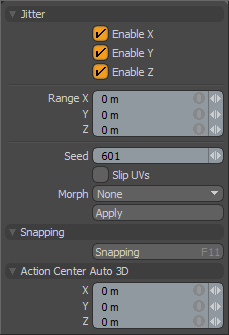


Found in the Deform sub-tab of the modeling toolbox (sometimes as a sub-option of the Smooth or Quantize tools), the Jitter tool repositions selected items or components based on a seed number and a range value for the X, Y, and Z axes. It applies a random offset to each vertex or item position for a more random, organic appearance. You can interactively apply the Jitter tool by dragging in the viewport or by typing Range values in the tool's Properties panel, and then click Apply. Changing the Seed value changes the random numbers to produce a variation on the results. This tool uses any active falloffs to target specific areas for the jitter.
Jitter—
Enable X/Enable Y/Enable Z: Enables the random jittering movement on a per axis basis for each axial direction.
Range X/Y/Z: Controls the maximum random offset distance. Changing this value adjusts the strength of the jittering effect.
Seed: Provides the initial number for Modo to use when generating the random values. Each seed produces different random results.
Slip Us: When enabled, edits applied to the geometry do not change the existing UV map. UV values are generally fixed to specific vertices; therefore, further edits to the geometry may warp, deform, or otherwise distort the UV values in undesirable ways. When this happens, you may need to adjust the map or to redo it altogether. To avoid this undesirable result, you enable Slip UVs so as to not disturb any existing UV mapping applied to the geometry.
|
Slip UVs function disabled (notice the texture warping) |
Slip UVs function enabled (texture remains even) |
Morph: Determines how Modo treats stored morphing information when applying transforms (such as the Move, Rotate, or Scale transforms) to geometry. There are three options for controlling how Modo deals with the morph map vertex data when applying any transforms.
None- Transforms selected (visible) morphs independent of their source, but does not affect unselected morph data.
Transform- Transforms morph data along with the base mesh.
Keep Positions- Converts morph data into an absolute morph map. All vertices retain their pre-transformed positions.
NOTE: In previous versions of Modo, to transform a morph along with its base, you needed to select it in the Vertex Map list. If you didn't, when Modo recalled the relative morph map data, it would produce distorted, undesirable results; therefore, it was easy to accidentally spoil a model. To remedy this problem, current versions of Modo have three options to deal with the morph map vertex data.
Snapping—
See the Snapping topic for details about this feature.
Action Center Auto 3D—
See the Action Centers topic for information.